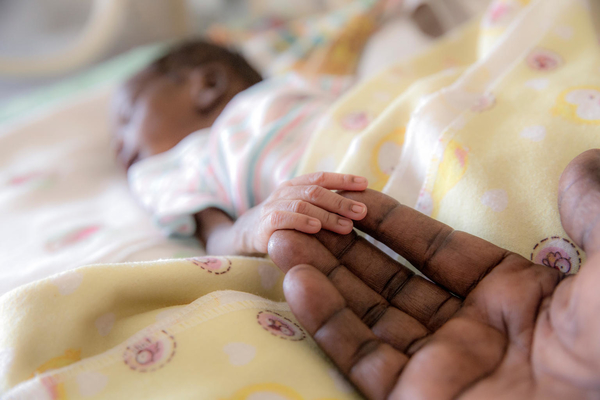Data science uncovers patterns in health service use linked to child mortality
Interdisciplinary WashU team identifies drivers of maternal and child health service use across countries

Children in sub-Saharan Africa have the world’s highest rates of under-5 mortality at 74 deaths per 1,000 live births, which is 14 times higher than the risk for children in North America and Europe. In 2021, sub-Saharan Africa accounted for more than 80% of under-5 mortality worldwide. Sadly, the causes of death, such as diarrhea, malaria and preterm birth, are mostly preventable or treatable.
An interdisciplinary team of AI and global health researchers at Washington University in St. Louis sought to determine how the use of reproductive, maternal, newborn and child health services may impact these stark rates. Using statistical learning to analyze a decade of data from 31 sub-Saharan African countries, the team identified key socioeconomic factors—such as maternal education and place of residence—that are strongly associated with whether mothers use available health services. Results of the research were published online Aug. 22 in Nature Communications.
Claire Najjuuko, a doctoral student at Washington University in St. Louis, analyzed a dataset of more than 9,000 births that resulted in death before age 5 availed by the Demographic and Health Survey program. She applied multilevel latent class analysis to 16 health service indicators, identifying three distinct groups of mothers — low, medium and high service users — and classifying countries into three categories based on overall service utilization patterns. She then applied multinomial regression to reveal how socioeconomic factors are linked to service usage patterns across different groups.
“Our study shows a strong link between socioeconomic factors and maternal and child health services use,” said Najjuuko, who is co-advised by Chenyang Lu, the Fullgraf Professor in the Department of Computer Science & Engineering in the McKelvey School of Engineering and director of the university’s AI for Health Institute, and Fred M. Ssewamala, formerly the William E. Gordon Distinguished Professor in the Brown School at WashU and now the Constance and Martin Silver Professor of Poverty Studies; Faculty Director, McSilver Institute for Poverty Policy and Research at New York University.
Some of the 16 variables that Najjuuko used as indicators of use of maternal and child health services included antenatal care, health facility-based deliveries, postnatal and postpartum care, breastfeeding and protective practices such as using improved sanitation facilities, access to safe drinking water and use of clean cooking fuels.
“We found high breastfeeding practices in young mothers of low socioeconomic status, likely because they have the time, and it’s the only option because they don’t have alternative nutrition for their babies,” Najjuuko said. “There were also lower odds of the mother having education, employment, living in urban areas or being in a high wealth tier in this low-utilization group. The medium-utilization group was characterized by a mixed panel, including health facility use, high antenatal attendance, high postnatal and postpartum care use, yet low rates of institutional delivery. In an earlier qualitative study, similar trends were reported by mothers. The mothers reported that they understood the importance of antenatal care, but reported having home deliveries, likely due to accessibility barriers, such as transportation.”
Najjuuko said the high utilization group had the highest prevalence of use of the health facility-based services, as well as the protective practices such as using improved sanitation facilities, having access to clean drinking water and using clean cooking fuels in their homes.
“This group additionally had a high proportion of met need for family planning, the recommended births spacing, marrying at above 18 years old and utilization of a wide continuum of care services before, during and after delivery which included majority of the 16 health service utilization indicators covered,” Najjuuko said.
In addition to the individual-level grouping, Najjuuko also grouped the data by country. They found that the coverage and use of these services varied by country due to socioeconomic, behavioral and cultural differences. More than half of the 31 countries had relatively high rates of use of maternal and child health services, likely because these countries have developed improved accessibility to maternal and child health services. However, other countries had a more fragmented utilization landscape with higher proportions of respondents with medium or low use of available services.
“Our findings show a strong link between socioeconomic status and maternal and child health services use,” Najjuuko said. “We need to target strategies toward the most socioeconomically disadvantaged groups. There have been other studies aimed at improving socioeconomic standing of families. It is a key to help people get out of poverty or to get more education and get knowledge about access to these life-saving services.”
Lu said the dataset is invaluable for improving public health and policy making.
“This multi-country dataset gives us really valuable insights to help shape health policies,” Lu said. “A lot of things we might assume — like going to a health facility for childbirth — actually show big differences across Africa, according to this survey. Policymakers can use these data-driven results because there’s so much information to help guide their decisions. For example, as Claire mentioned, some mothers know they should go to a hospital but can’t because of barriers like transportation. These findings give clear, precise insights about what kinds of policies could work in different countries and help policymakers make the best use of resources.”
Najjuuko C, Xu Z, Kizito S, Lu C, Ssewamala FM. Patterns of maternal, newborn, and child health services utilization, and associated socioeconomic disparities in sub-Saharan Africa: Multilevel latent class analysis. Nature Communications. Published online Aug. 22, 2025, https://doi.org/10.1038/s41467-025-61350-8.
This study was supported in part by funding from the National Institutes of Health Researcher Resilience Training grant (R25MH118935-01), the AI for Health Institute and the Fullgraf Foundation.






